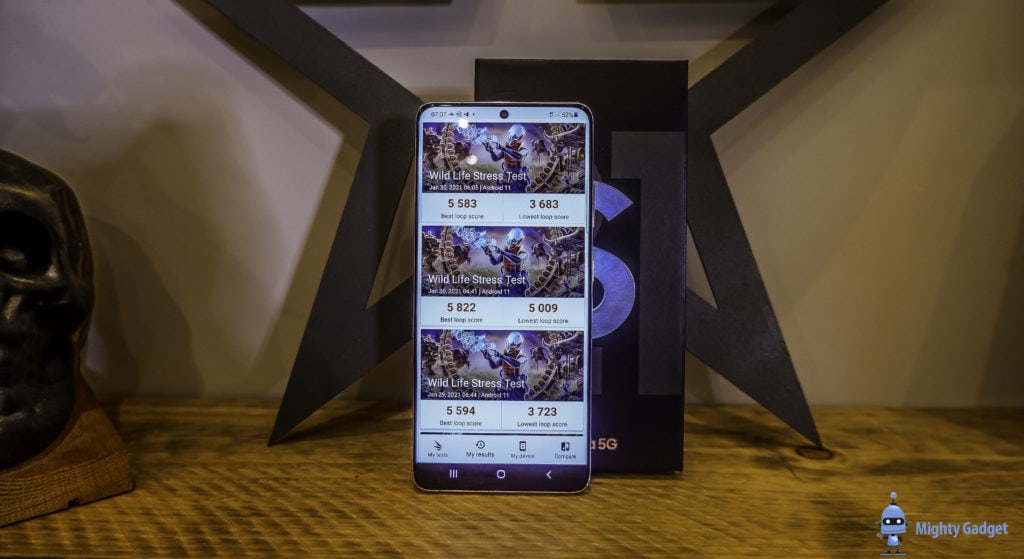Any links to online stores should be assumed to be affiliates. The company or PR agency provides all or most review samples. They have no control over my content, and I provide my honest opinion.
MediaTek is just starting its Executive summit in Los Angeles, where we will be getting to learn more about the new flagship MediaTek Dimensity 9300. This new chipset claims to be better (at least in some areas) than the flagship Qualcomm Snapdragon 8 Gen 3 chipset that was launched a month ago. Whether that is true, time will tell. Either way, it is a good time for consumers.
Yesterday, I posted a comprehensive history of MediaTek and therefore, it is only fair to post a similar history of their main competitor, Qualcomm.
Introduction: The Pioneering Journey of Qualcomm
Founded in 1985 by seven former Linkabit employees led by Irwin Jacobs, Qualcomm has emerged as a global leader in wireless technologies and semiconductors over its nearly 40 year journey. The company was aptly named “Qualcomm” for “Quality Communications” with a vision to build high-quality communication systems.
In its early years, Qualcomm focused on developing the CDMA (Code Division Multiple Access) technology for cellular communications. It filed foundational patents starting in 1989, including for power control and soft handoff techniques to address issues like the near-far problem in CDMA networks.
Despite initial industry scepticism, Qualcomm persisted and demonstrated the commercial viability of CDMA. It achieved a major milestone when the Cellular Telecommunications Industries Association reopened the cellular standards debate in 1991 to consider CDMA.
Qualcomm went public in 1991 to raise funds for developing the CDMA infrastructure.
It signed partnerships with major manufacturers like Nokia and worked relentlessly to promote CDMA globally throughout the 90s. The efforts paid off as CDMA gained widespread acceptance, especially in Asia and North America. By 1997, 57% of digital wireless systems under construction used CDMA.
Qualcomm also diversified into semiconductors and chipsets. It launched the first CDMA chipset integrating GPS in 2000 and introduced the pioneering Snapdragon processor in 2007. Snapdragon powered the first Android phone in 2008 and went on to become the world’s leading mobile chipset.
Qualcomm today is a global leader in 5G, AI, automotive technologies and other cutting-edge fields.
From humble beginnings in 1985, Qualcomm has traversed an eventful journey to become a semiconductor giant with $33 billion in 2022 revenues.
Its pioneering technologies and relentless execution catalysed the growth of the cellular industry and fuelled the smartphone revolution. Qualcomm today powers billions of devices globally, a testament to its sustained technology leadership over nearly four decades.
Corporate History and Evolution
Key Milestones
- 1985: Qualcomm is founded by seven former Linkabit employees led by Irwin Jacobs and Andrew Viterbi. The company is named “Qualcomm” for “Quality Communications”.
- 1989: Qualcomm files foundational patents for CDMA technology, which becomes the basis for its future growth.
- 1991: Qualcomm goes public to raise funds for developing CDMA infrastructure.
- 1995: Qualcomm starts licensing CDMA technology to major manufacturers like Nokia, accelerating adoption.
- 1999: Qualcomm exits the base station and cell phone hardware businesses to focus on licensing and chipsets.
- 2000: Qualcomm launches the first CDMA chipset integrating GPS capabilities.
- 2007: Qualcomm introduces the Snapdragon processor, which goes on to become the world’s leading mobile chipset.
- 2008: Snapdragon powers the first Android smartphone, the T-Mobile G1.
- 2011: Qualcomm acquires chipmaker Atheros to strengthen Wi-Fi offerings.
- 2016: Qualcomm announces the first 5G modem and completes 5G trials with operators.
Evolution through the Decades
In the 1990s, Qualcomm pioneered and commercialised CDMA technology for 2G networks. It licensed CDMA widely and developed custom chipsets, establishing itself as a leader.
In the 2000s, Qualcomm cemented its dominance in 3G with CDMA2000/EV-DO. It also diversified into application processors with Snapdragon and became the leading chip supplier for smartphones.
In the early 2010s, Qualcomm was at the forefront of 4G LTE and consolidated its position as the primary chip supplier for Android smartphones.
In the mid 2010s, Qualcomm expanded into adjacent technologies like Wi-Fi, Bluetooth, automotive, and networking. It also invested heavily in 5G research.
In the late 2010s, Qualcomm commercialised the world’s first 5G modem and chipsets. It continues to lead in 5G today across mobile, infrastructure, automotive and IoT.
Over nearly four decades, Qualcomm has demonstrated continued technology leadership across generations of cellular technology, from 2G to 5G. Its ability to combine systems-level understanding with chip-level innovations has been key to its success.
Key Acquisitions and Integration
Qualcomm has made several strategic acquisitions to expand its capabilities and cement its leadership in wireless technologies.
Major Acquisitions
Atheros Communications (2011): Qualcomm acquired this WiFi chipset company for $3.1 billion to strengthen its connectivity portfolio beyond 3G/4G. Atheros’ WiFi and Ethernet chips are now integrated across Qualcomm chipsets.
- NXP Semiconductors (2018): Qualcomm attempted to acquire NXP for $47 billion to bolster its presence in automotive, security and IoT segments. The deal was called off due to lack of Chinese regulatory approval.
- RF360 Holdings (2019): Qualcomm acquired this JV between TDK and NXP to obtain RF filter capabilities and expand its RF front-end offerings. It was a $3.1 billion deal.
- NuVia (2021): Qualcomm acquired this startup focused on 800G optical interconnects for data centers for $1.4 billion, to strengthen its presence in 5G infrastructure.
Integration and Evolution
Acquisitions have been integrated smoothly within Qualcomm, with the teams transitioning to being part of the Qualcomm ecosystem. For instance, Atheros’ offerings have evolved into Qualcomm Wi-Fi 6/6E and Bluetooth 5/5.2 chipsets today.
Qualcomm also integrates the acquired capabilities like RF filters or optical interconnects into its own chipsets and platforms. NuVia’s optical technology will augment Qualcomm’s 5G infrastructure and O-RAN offerings for instance.
Strategic acquisitions focused on expanding capabilities have been crucial for Qualcomm to maintain its competitive edge across wireless technologies through the decades.
Financial Performance
Revenue Growth
Qualcomm has seen steady revenue growth over the past decade, from $19.1 billion in FY2013 to $33.6 billion in FY2022. This represents a compounded annual growth rate of 5.8%.
Key drivers of Qualcomm’s revenue growth include:
- Growing smartphone shipments and Qualcomm’s high share in mobile chipsets
- Diversification into adjacent segments like automotive, IoT and networking
- Expansion of licensing programs, especially in China
While Qualcomm revenues declined in FY2023 due to economic conditions, its long-term growth trends remain positive.
Profitability
Qualcomm has maintained strong profitability over the years. Its non-GAAP net income margin has averaged 25% over the past decade.
Key factors enabling Qualcomm’s profitability include:
- High gross margins from its licensing business
- Operating leverage from its asset-lite, fabless manufacturing model
- Disciplined cost management
The high margins indicate Qualcomm’s ability to effectively monetize its IP and drive operational efficiency. This provides a solid financial base for R&D investments.
Market Share
Qualcomm holds leading market share in key segments:
- Mobile chipsets: Qualcomm has 65-75% share in smartphone application processors and modems.
- Automotive chipsets: Qualcomm has ~25% share in automotive connectivity/telematics chips.
- Wireless infrastructure: Qualcomm holds a significant share in 5G RAN/small cells.
Qualcomm’s dominance in mobile chipsets provides a solid foundation as it diversifies into adjacent growth areas. Sustaining technology leadership will be key for maintaining its strong market position.
Wireless CDMA
Qualcomm played a pioneering role in the development and commercialization of CDMA (Code Division Multiple Access) technology for cellular communications. Here is an overview of Qualcomm’s key contributions:
The Inception of CDMA
- In 1989, Qualcomm engineers led by Irwin Jacobs and Andrew Viterbi filed foundational patents for CDMA technology. This included patents for power control and soft handoff techniques.1
- Qualcomm proposed CDMA as a digital wireless technology to address capacity and quality issues with existing analogue and digital (TDMA) cellular standards. CDMA allowed multiple users to simultaneously access a channel by spreading signals across the spectrum.
- Despite industry scepticism, Qualcomm demonstrated the commercial viability of CDMA through partnerships and trials with operators in the early 1990s.
Popularizing CDMA Globally
- Qualcomm licensed CDMA technology to major manufacturers like Nokia and Ericsson, accelerating its adoption.
- It worked relentlessly throughout the 1990s to promote CDMA, especially in North America and Asia. CDMA gained widespread acceptance – by 1997, 57% of digital wireless systems under construction were CDMA-based.1
- Qualcomm drove the standardization of CDMA as IS-95 for 2G networks. This cdmaOne standard laid the foundation for the transition to 3G based on CDMA technology.
Impact on the Mobile Industry
- CDMA enabled key innovations like soft handoffs, capacity improvements through voice activity detection, and integration of data services.
- It provided higher quality, capacity and bandwidth compared to analogue and TDMA networks. This fueled the growth in mobile subscriptions globally.
- The evolution to 3G standards like CDMA2000 and WCDMA was built on Qualcomm’s foundational CDMA work. This ushered in the era of smartphones and mobile broadband.
- Qualcomm’s pioneering role in CDMA and its transition to 3G was crucial in catalyzing the dramatic growth of the cellular industry over the last three decades.
Qualcomm’s Venture into 3G, 4G, and 5G
3G
- In the 1990s, Qualcomm drove the evolution of CDMA technology to 3G standards like CDMA2000 and WCDMA.
- Qualcomm’s foundational work on efficient voice coding, power control, and soft handoff enabled the transition to 3G.
- Qualcomm chipsets and licensing programs were pivotal in accelerating the adoption of 3G networks globally.
4G
- Qualcomm began investing in 4G LTE research in the 2000s, years before standardization.
- It commercialized the world’s first multimode 3G/4G chipset in 2009, accelerating the rollout of 4G.
- Qualcomm’s LTE leadership was built on its expertise in advanced OFDM, MIMO and heterogeneous network techniques.
5G
- Since the 2010s, Qualcomm has pioneered key 5G innovations like mmWave, massive MIMO, 5G NR, and small cells.
- It unveiled the first 5G modem in 2016 and commercial 5G chipsets in 2018, enabling the 5G transition.
- Qualcomm today powers most 5G smartphones and is expanding into 5G infrastructure, networking and automotive.
Industry Transformation
- 3G enabled the transition to digital voice, mobile data, and multimedia services on cell phones.
- 4G LTE ushered in the era of advanced smartphones, mobile apps, and high-speed broadband.
- 5G is transforming industries with ultra-low latency, gigabit speeds, and massive connectivity.
- Across generations, Qualcomm’s technologies and leadership have been crucial for advancing wireless performance and capabilities.
- Its inventions and R&D investments have played a key role in revolutionizing the mobile experience and industry.
History of Qualcomm Snapdragon Mobile Phone Chipsets
Launched in 2007, Snapdragon was Qualcomm’s knight in shining armour, designed to cater to the burgeoning demands of the emerging smartphone and tablet era. The inception of Snapdragon was a calculated stride towards redefining mobile processing, offering a blend of robust processing capabilities, enhanced graphics, and efficient power consumption.
Key Points
- The Snapdragon brand was launched in November 2007 with the QSD8250, featuring the first 1GHz processor for mobile phones.
- In 2011, Qualcomm introduced the Krait CPU microarchitecture in Snapdragon, allowing dynamic CPU speed based on workload.
- Snapdragon chipsets enabled smartphones with gigahertz speeds starting 2007 when 500MHz was common.
- Introduced advanced capabilities like AI, computational photography, gaming enhancements over the years.
- Snapdragon played a pivotal role in the evolution of mobile computing from 4G to 5G, from HD to 4K displays, basic to advanced photography.
- Consistent technology leadership and integration of modem, CPU, GPU, AI engine into one chip was key to enabling new mobile experiences.
History of the Qualcomm Snapdragon 8 Series
Due to the large number of Qualcomm chipsets over the years, I have only focussed on the flagship 8 series for now.
Snapdragon 800 (2013)
- First Snapdragon 800 series chipset
- Quad-core Krait 400 CPU, Adreno 330 GPU
- Supported 4K video, LTE Cat 4, USB 3.0
- Phones: LG G2, Nexus 5, Sony Xperia Z1
Snapdragon 801 (2014)
- Iterative update to Snapdragon 800
- Improved CPU and GPU performance
- Phones: Samsung Galaxy S5, HTC One M8, Sony Xperia Z2
Snapdragon 805 (2014)
- Quad-core Krait 450 CPU, Adreno 420 GPU
- Supported 4K display output and H.265 video encoding
- Phones: Samsung Galaxy Note 4, Motorola Nexus 6
Snapdragon 810 (2015)
- First 64-bit Snapdragon chipset
- Octa-core CPU, Adreno 430 GPU
- Overheating issues in some phones
- Phones: LG G Flex 2, HTC One M9, Sony Xperia Z5
Snapdragon 820 (2016)
- Quad-core Kryo CPU, Adreno 530 GPU
- 14nm manufacturing, improved efficiency
- Phones: Samsung Galaxy S7/S7 Edge, LG G5
Snapdragon 835 (2017)
- Octa-core Kryo CPU, Adreno 540 GPU
- First 10nm Snapdragon chipset
- Phones: Samsung Galaxy S8/S8+, Google Pixel 2/2 XL
Snapdragon 845 (2018)
- Octa-core Kryo 385 CPU, Adreno 630 GPU
- Dedicated AI engine, improved camera ISP
- Phones: Samsung Galaxy S9/S9+, OnePlus 6
Snapdragon 855 (2019)

- Octa-core Kryo 485 CPU, Adreno 640 GPU
- First Snapdragon with integrated 5G modem
- Phones: Samsung Galaxy S10, OnePlus 7 Pro
Snapdragon 865 (2020)
- Octa-core Kryo 585 CPU, Adreno 650 GPU
- 5nm process, 144Hz display support
- Phones: Samsung Galaxy S20, OnePlus 8 Pro
Snapdragon 888 (2021)

- Octa-core Kryo 680 CPU, Adreno 660 GPU
- Improved AI engine, ISP, 5G modem
- Phones: Samsung Galaxy S21, OnePlus 9 Pro
Snapdragon 8 Gen 1 (2022)
- Octa-core (1x X2 + 3x A710 + 4x A510)
- Adreno 730 GPU, 4nm process
- Phones: Samsung Galaxy S22, OnePlus 10 Pro
Snapdragon 8 Gen 2 (2023)

- Octa-core (1x X3 + 2x A715 + 2x A710 + 3x A510)
- Adreno 740 GPU, 4nm process
- Phones: Samsung Galaxy S23, Honor Magic5 Pro
Snapdragon 8 Gen 3 (2024)
- Octa-core(1x X4 + 5x A720 + 2xA520)
- Adreno 750 GPU, 4nm process
- Phones: Xiaomi Mi 15
History of the Qualcomm Mixed Reality (MR) Platforms
Qualcomm entered the mixed reality space in the early 2010s, developing custom chipsets and software platforms to power AR/VR devices.
Key milestones include:
- 2014: Qualcomm launches the Snapdragon VR820 reference platform for virtual reality.
- 2016: Qualcomm unveils the Snapdragon 835 VR development kit for high-end VR experiences.
- 2018: Qualcomm announces the Snapdragon XR1 platform targeting standalone AR/VR headsets.
- 2019: Qualcomm launches the Snapdragon XR2 platform with 5G support and advanced visuals.
- 2022: The Snapdragon XR2+ platform is announced with performance and thermal improvements.
- 2023: Snapdragon XR2 Gen 2 platform unveiled with 50% faster GPU and AI processing.
Notable Devices Powered by Qualcomm
- Oculus Quest 2 (2020): Popular standalone VR headset powered by Snapdragon XR2, offering high fidelity visuals.
- Vive Focus 3 (2021): Enterprise-focused standalone VR headset using Snapdragon XR2 for low latency.
- Meta Quest Pro (2022): High-end mixed reality headset with Snapdragon XR2+, hand/eye tracking.
- Lenovo ThinkReality VRX (2022): Lightweight AR glasses for enterprises using Snapdragon XR1.
- Oppo Air Glass (2022): AR monocular smart glass powered by Snapdragon 4100, projecting visuals.
Qualcomm has established itself as a leading technology provider for mixed reality with its custom chipsets and platforms powering major headsets and smart glasses. Its integration of 5G, AI, computer vision and graphics capabilities has been key.
History of the Gaming Platforms
Qualcomm entered the gaming space in the late 2000s, optimizing its Snapdragon mobile chipsets for gaming. Key milestones include:
- 2009: The Snapdragon S1 features an Adreno 200 series GPU, bringing improved graphics to phones.
- 2013: The Snapdragon 800 debuts the Adreno 330 GPU, offering console-quality graphics on mobile.
- 2016: Snapdragon 820 introduces the Adreno 530 GPU with support for Vulkan API, VR/AR and HDR gaming.
- 2018: Snapdragon 845 brings an Adreno 630 GPU focused on maximizing graphics performance.
- 2021: Qualcomm unveils the Snapdragon G3x platform purpose-built for dedicated gaming handhelds.
- 2022: Snapdragon G3x Gen 1 platform is launched with hardware ray tracing support.
Notable Gaming Devices
- Razer Phone (2017): First phone optimized for gaming with Snapdragon 835 and 120Hz display.
- Asus ROG Phone II (2019): Powerful gaming phone with Snapdragon 855 Plus, 120Hz AMOLED display.
- Lenovo Legion Phone Duel (2020): Innovative gaming phone with Snapdragon 865 Plus and pop-up selfie camera.
- Logitech G Cloud (2022): Android cloud gaming handheld using Snapdragon 720G.
- Razer Edge (2022): 5G gaming handheld with Snapdragon G3x Gen 1, 144Hz OLED display.
Qualcomm has continuously improved graphics, display, audio and connectivity capabilities in its chipsets to deliver immersive high-fidelity mobile gaming experiences. Its Snapdragon platforms have powered many innovative gaming phones and handhelds.
History of the Bluetooth SoC Platforms
Qualcomm has developed various Bluetooth audio system-on-chip (SoC) platforms over the years to power wireless audio devices:
- CSR8000 series (2015) – Entry-level Bluetooth audio SoC for compact wireless speakers and headphones.
- QCC5100 series (2018) – Premium Bluetooth audio platform with integrated DSP and support for aptX audio codec. Powers wireless earbuds and headphones.
- S3/S4 platforms (2019) – Low power platform for voice-based hearables and earbuds. Enables voice assistants integration.
- S5 platform (2021) – High-end platform with support for lossless audio, voice concierge and ANC. Targeted at premium wireless earbuds.
- QCC30xx series (2021) – Entry-level flash programmable SoCs for Bluetooth headsets and earbuds. Focused on low power consumption.
Notable Devices
- Bose QuietComfort Earbuds (2020) – Featured the QCC514x SoC for active noise cancellation.
- Sennheiser Momentum True Wireless 2 (2020) – Used the QCC514x SoC to enable advanced audio capabilities.
- Amazon Echo Buds (2nd Gen, 2021) – Powered by the S3 platform for Alexa integration.
- Samsung Galaxy Buds2 Pro (2022) – Utilized the S5 platform to deliver 24-bit audio and spatial audio.
Qualcomm’s Bluetooth audio SoCs have enabled major audio brands to build advanced wireless earbuds with active noise cancellation, voice assistant support, high-resolution audio and other premium features. The integration of application processors, Bluetooth, and audio DSP has been key.
I am James, a UK-based tech enthusiast and the Editor and Owner of Mighty Gadget, which I’ve proudly run since 2007. Passionate about all things technology, my expertise spans from computers and networking to mobile, wearables, and smart home devices.
As a fitness fanatic who loves running and cycling, I also have a keen interest in fitness-related technology, and I take every opportunity to cover this niche on my blog. My diverse interests allow me to bring a unique perspective to tech blogging, merging lifestyle, fitness, and the latest tech trends.
In my academic pursuits, I earned a BSc in Information Systems Design from UCLAN, before advancing my learning with a Master’s Degree in Computing. This advanced study also included Cisco CCNA accreditation, further demonstrating my commitment to understanding and staying ahead of the technology curve.
I’m proud to share that Vuelio has consistently ranked Mighty Gadget as one of the top technology blogs in the UK. With my dedication to technology and drive to share my insights, I aim to continue providing my readers with engaging and informative content.







